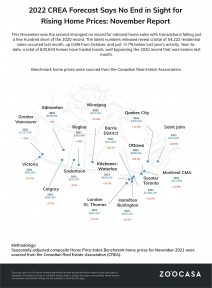This November was the second-strongest on record for national home sales with transactions falling just a few hundred short of the 2020 record, according to the Canadian Real Estate Association (CREA).
The latest numbers released by the national housing body reveal a total of 54,222 residential sales occurred last month, up 0.6% from October, and just -0.7% below last year’s activity. Year-to-date, a total of 630,634 homes have traded hands, well bypassing the 2020 record that was broken last month.
The market also benefited short term from some sorely needed new supply as 70,406 homes were brought online, a 3.3% uptick from the previous month, though still -4.6% below 2020’s November levels.
However, those new listings fell short of making a dent in today’s fierce, seller-friendly market; the average home price continued its record-breaking trajectory, rising 19.6% to $720,850 (stripping Vancouver and Toronto out of the equation would lower that average to $562,820), while the MLS Home Price Index rose 25.3% year over year.
While the market showed some slight easing compared to October’s record breaking frenzy, Cliff Stevenson, CREA’s Chair, says an unprecedented supply and demand imbalance continues to underpin current market trends.
“November provided another month of evidence that the housing supply/demand issues facing the country have not gone away,” he stated in the association’s release. “Even at what is traditionally the slow time of year for housing, conditions and price trends are at the same record levels we saw this spring. Things may calm down a bit through the balance of December and January, but next year’s spring market will no doubt be an interesting one.”
November’s uptick follows an extremely volatile year for sales with CREA noting a roller coaster of activity, from a record-breaking 807,250 sales in March, plunge to 585,250 in August, and rebound to 650,000 in the late fall.
New Listings Ease Short-Term Pressure, But Make No Dent in Supply Scarcity
The scant 3.3% increase in new supply improved conditions very slightly for buyers, with the national sales-to-new-listings ratio (SNLR) dipping to 77%, from 79% in October. This ratio, which is calculated by dividing the number of sales by the number of new listings over the course of the month, determines the level of competition in the housing market. A range between 40 – 60% indicates a balanced market, with above and below that threshold indicating sellers’ and buyers’ markets, respectively.
According to CREA, two-thirds of all local markets can be considered to be in sellers’ territory, with the remaining experiencing balanced conditions. Currently, there are no markets in Canada that can be considered in favour of buyers.
Overall inventory – the number of months it would take to completely sell off all homes for sale in current conditions should no new listings be introduced – currently sits at 1.8 months, tied with March levels as the lowest in history, and well below the long-term average of 5.5 months. CREA notes this metric has fallen below the two-month mark four times this year, first in February – March, and again in October – November, which has contributed significantly to this year’s record price growth.
Check out the infographic below to see how prices trends in Canada’s major urban centres in November :

2022 CREA Forecast Says No End in Sight for Rising Home Prices by Penelope Graham | Zoocasa November Report


Recent Comments